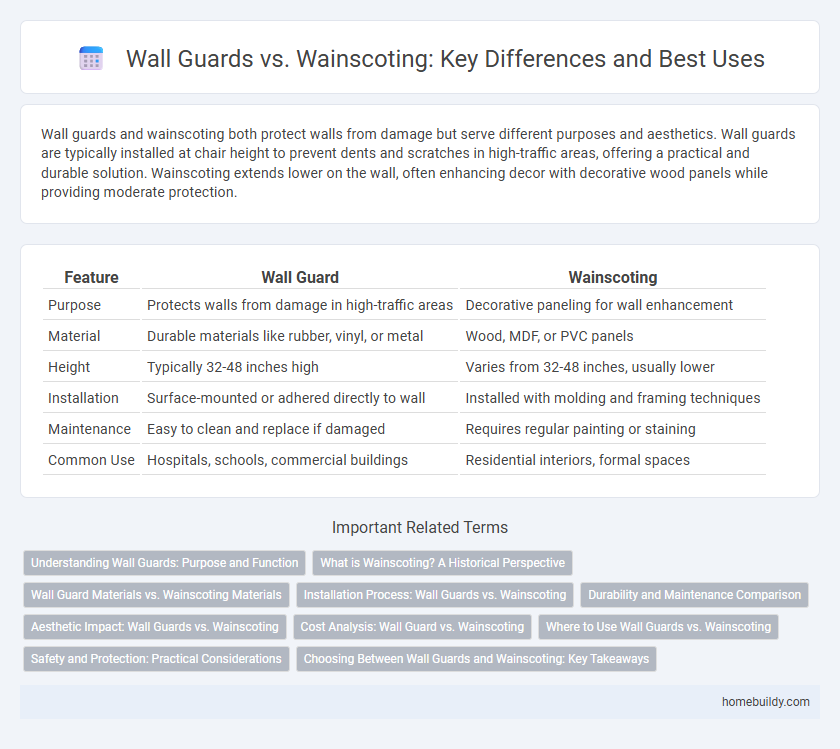Wall guards and wainscoting both protect walls from damage but serve different purposes and aesthetics. Wall guards are typically installed at chair height to prevent dents and scratches in high-traffic areas, offering a practical and durable solution. Wainscoting extends lower on the wall, often enhancing decor with decorative wood panels while providing moderate protection.
Table of Comparison
| Feature | Wall Guard | Wainscoting |
|---|---|---|
| Purpose | Protects walls from damage in high-traffic areas | Decorative paneling for wall enhancement |
| Material | Durable materials like rubber, vinyl, or metal | Wood, MDF, or PVC panels |
| Height | Typically 32-48 inches high | Varies from 32-48 inches, usually lower |
| Installation | Surface-mounted or adhered directly to wall | Installed with molding and framing techniques |
| Maintenance | Easy to clean and replace if damaged | Requires regular painting or staining |
| Common Use | Hospitals, schools, commercial buildings | Residential interiors, formal spaces |
Understanding Wall Guards: Purpose and Function
Wall guards provide a protective barrier designed to prevent damage to walls from impact, particularly in high-traffic areas such as hospitals, schools, and commercial buildings. Unlike wainscoting, which primarily serves a decorative purpose while offering some protection, wall guards are constructed from durable materials like vinyl, rubber, or metal to absorb shocks and resist scratches. Their primary function is to preserve wall integrity and reduce maintenance costs by minimizing dents, scuffs, and holes caused by carts, wheelchairs, or furniture.
What is Wainscoting? A Historical Perspective
Wainscoting is a traditional interior wall treatment featuring wooden paneling that originated in 16th-century Europe to provide insulation and protect plaster walls from damage. Historically, wainscoting served both decorative and functional purposes, often covering the lower third of walls in rooms to add elegance and durability. Unlike modern wall guards, which prioritize impact resistance in high-traffic areas, wainscoting emphasizes aesthetic appeal and architectural detail alongside moderate protection.
Wall Guard Materials vs. Wainscoting Materials
Wall guards are typically made from durable materials such as vinyl, rubber, or PVC designed to protect walls from impact damage, especially in high-traffic areas. In contrast, wainscoting materials often include wood, MDF, or beadboard, which focus more on aesthetic enhancement and partial wall coverage. The choice between the two depends on whether the priority is protection and resilience or decorative appeal and texture.
Installation Process: Wall Guards vs. Wainscoting
Wall guards typically offer a straightforward installation process involving adhesive backing or simple mounting brackets, making them ideal for quick and damage-free application in high-traffic areas. Wainscoting requires more intensive labor, including measuring, cutting, nailing, and painting, often necessitating professional skills to ensure precise alignment and finish. Choosing wall guards over wainscoting significantly reduces installation time and complexity while providing durable protection against impacts and abrasions.
Durability and Maintenance Comparison
Wall guards offer superior durability compared to wainscoting due to their robust materials like vinyl or rubber, which resist impacts and wear more effectively. Maintenance for wall guards is minimal, often requiring just simple cleaning with soap and water, whereas wainscoting demands regular painting or sealing to prevent damage from moisture and scratches. Choosing wall guards ensures long-lasting protection with lower upkeep, making them ideal for high-traffic areas needing consistent impact resistance.
Aesthetic Impact: Wall Guards vs. Wainscoting
Wall guards provide a sleek, functional aesthetic designed to protect walls from damage in high-traffic areas, often featuring durable materials like vinyl or rubber that blend seamlessly with modern interiors. In contrast, wainscoting offers a more decorative and traditional look, using wood panels or beadboard to add texture and architectural detail while also protecting lower wall sections. Choosing between wall guards and wainscoting depends on the desired balance of durability, maintenance, and visual appeal in a space.
Cost Analysis: Wall Guard vs. Wainscoting
Wall guards generally offer a more cost-effective solution compared to wainscoting, with typical installation expenses ranging from $10 to $30 per linear foot versus $30 to $75 per linear foot for wainscoting. Wall guards require less material and labor investment, making them ideal for high-traffic commercial environments seeking protection with budget constraints. Wainscoting, while more expensive, provides a decorative appeal and enhanced durability, justifying higher costs in upscale or residential applications.
Where to Use Wall Guards vs. Wainscoting
Wall guards are ideal for high-traffic areas such as hospitals, schools, and commercial buildings where protection against impact and abrasion is crucial, typically installed at 32 to 48 inches along walls. Wainscoting is primarily used in residential or decorative spaces to enhance aesthetic appeal and provide moderate wall protection, usually covering the lower third of a wall up to 36 inches high. Choosing wall guards over wainscoting depends on the need for durability and impact resistance versus decorative enhancement.
Safety and Protection: Practical Considerations
Wall guards provide superior impact resistance and durability, making them ideal for high-traffic areas where safety and protection are critical. Unlike wainscoting, which primarily serves decorative purposes, wall guards are engineered to absorb and deflect physical damage caused by carts, wheelchairs, or equipment. Their materials often include vinyl, rubber, or metal, enhancing wall protection while reducing maintenance costs in commercial and healthcare environments.
Choosing Between Wall Guards and Wainscoting: Key Takeaways
Wall guards provide durable protection against impact in high-traffic areas, making them ideal for hospitals and commercial spaces, while wainscoting enhances aesthetic appeal with decorative paneling suitable for residential interiors. Selecting between wall guards and wainscoting depends on the primary purpose: functional protection versus visual design. Consider material durability, maintenance requirements, and overall style impact when choosing the appropriate wall treatment.
Wall guard vs Wainscoting Infographic

 homebuildy.com
homebuildy.com